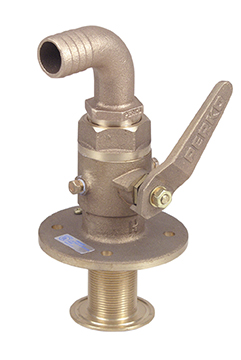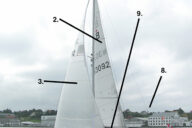Written by Rudy & Jill Sechez for Blue Water Sailing
The American Boat and Yacht Council (ABYC) has developed standards for the installation of thru-hulls. These state, in part: “When installed below the maximum heeled water line, a thru-hull must have a valve mounted so that the system will withstand a 500-pound static force applied for 30 seconds to the inboard end of its connecting fitting.”
The valves referred to are called seacocks, and they are used to control the intake or discharge of water through the hull. According to the ABYC, seacocks should be “operated by a lever-type handle, usually through a 90-degree arc, giving a clear indication of whether the valve is open or shut.”
To satisfy these requirements, not just any valve can be used below the maximum heeled water line. Instead, a special type is required; one that has a flange, which will disperse loads, and a lever, which will give a clear indication of whether the valve is open or shut. This kind of valve is referred to as a “flanged seacock.”
BUILDING STRENGTH
Even when a flanged seacock is used, it needs more than its flange to pass the ABYC’s 500-pound static force test; it also needs to be installed strongly enough so that the joint between it and the thru-hull does not fail. One way to provide this strength is to thru-bolt the seacock to the hull, using holes drilled in the flange.
Another method is to simply screw the seacock to the thru-hull. A minimum of five threads must be fully engaged in order to produce a joint that develops full strength. To accomplish this, straight threads must be screwed into straight threads, and tapered threads must be screwed into tapered threads.
Fortunately, all thru-hulls, as well as the threads in the bottom of all seacocks, are manufactured with straight threads. Not only does this allow for a strong joint, but it also allows a thru-hull to be cut down and still be screwed into the seacock to form a strong and tight joint; this is something that could not be done if the threads were tapered.
Matching threads on connecting fittings, or other components that are used downstream of the seacock, is not quite so simple. Some manufacturers use straight threads, while others use tapered. But this task isn’t really that difficult; simply take into consideration the material from which the components are made.
Bronze components use tapered threads. The threads in the top of bronze seacocks, as well as bronze in-line valves, raw water strainers, raw water manifolds, safety seacock conversion adapters and bronze fittings all have tapered threads. Components made out of Marelon (a material that Forespar uses), on the other hand, have straight threads. So the threads in the tops of a Marelon seacock, as well as those in Marelon in-line valves, water strainers, and all but one of the Marelon fittings, all have straight threads.
THBVs, IBVFs AND
COMBO THREADS
Previously, flanged seacocks were the only valves that could be screwed onto a thru-hull and pass the ABYC’s 500-pound test; now, there is an alternative. Groco manufactures a base that has a flange, straight female threads in its base and tapered male threads on its top. They call this flanged base a “thru-hull ball valve adapter” (THBV adapter) or an in-line ball valve flange (IBVF). Because of its features, the installation of an IBVF on a thru-hull allows an exception to the prohibition of using in-line valves on thru-hulls located below the maximum heeled waterline, and the combination will pass the ABYC’s 500 lb test.
In addition, with an IBVF installed, the in-line valve can be replaced without having to violate the thru-hull’s seal on the boat’s hull.
There is also a relatively new style of thread being used by Groco and Perko on their bronze thru-hulls, which they call a “combination thread.” These are made with straight threads for most of their length, while the last few threads convert to tapered threads. The tapered threads allow the use of fittings that have tapered threads, such as those found on any bronze valve or fitting; or, any fitting with straight threads, such as a seacock or IBVF. Since thru-hulls with combination threads will produce a strong joint with just about any valve or fitting of the correct size, they are acceptable for use above the maximum heeled waterline.
Below the maximum heeled waterline, a strong joint is not enough. A load-dissipating flange must also be included. So these thru-hulls, even with their combination threads, must be used in conjunction with a flanged seacock or an IBVF below the maximum heeled water line.
MIXING MATERIALS
Marelon components can be, and often are, intermixed with bronze components. As long as the thread types match, there is seldom trouble. But since Marelon and bronze expand and contract at different rates, combining fittings of these materials can result in leaks. It is generally recommended not to mix the two. Instead, it is best to fit bronze with bronze and Marelon with Marelon.
SEALANTS
Threads that tighten against themselves, as tapered threads do, are self-sealing and generally do not require the use of a sealant to prevent leaks. If a sealant is needed, regular pipe dope or Teflon tape is usually adequate.
All straight threads, and tapered threads that stop short of self-sealing, require the use of a sealant. If the joint is under pressure, as it would be below the water line, a hard-setting sealant should be used. In addition, the entire assembly needs to be well bedded and sealed against the hull to prevent leaks.
There are many sealants available. Life Caulk and 3M-101 (polysulfides) or 3M-5200 and 4200 (polyurethanes) work well in this application, both for sealing threads and bedding the components. Plus, they have the added advantage of being commonly found in boatyards and chandleries.
HULL SHAPE AND
BACKING BLOCKS
All flanged seacocks and IBVFs need to be installed against a flat surface. If the surface of the hull is curved, no matter how slight, the area where the seacock mates with the hull needs to be made flat in some manner.
Backing blocks, with a footprint that is at least 10% larger than the flange, are needed on hulls that are thin. The smaller the fitting, the more important this is. If the need for a backing block is in question, it is best to install one as a precaution. For those installations that may require them, extra long thru-hulls are available.
FIELD TESTING FOR STRENGTH
Dragging a 500-pound test weight and a stopwatch onto a boat to test a thru-hull’s strength is rather impractical. Instead, a field test can be improvised. Have someone stand on the fitting, bouncing lightly or yanking the heck out of it. If a joint is going to fail, it is better to discover it while the boat is in the yard or in a slip.
TAPERED PLUGS
Every thru-hull should have a tapered plug attached to it, or nearby. Traditionally, these plugs were made out of softwood, but recently plastic tapered plugs have become available and hardwood plugs can also be found.
One advantage that softwood plugs have over the others is that once wet, they swell relatively quickly. This swelling allows the plug to seal tighter and makes them less likely to be dislodged.
Those who were previously frustrated when installing thru-hulls should now find the process easier. Just remember three things. First, use materials that that are compatible with one another and suited for the medium in which they will be used. Next, match like sizes. And finally, fit straight threads to straight threads and tapered threads to tapered threads. You might just find that it isn’t so difficult after all!
Rudy and Jill enjoy simple, strong, safe, economical boats. They have been cruising and living aboard since 1997, and have sailed through the eastern U.S., Florida, Bahamas, Bermuda and part of the Great Lakes. They currently live and cruise aboard a 34-foot sail-assisted wooden trawler, which they designed and built.












